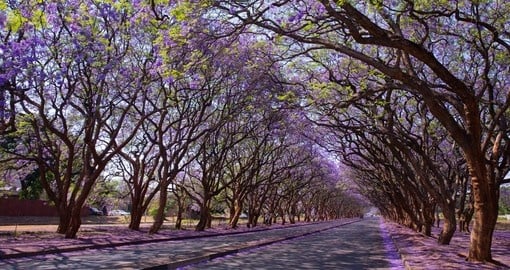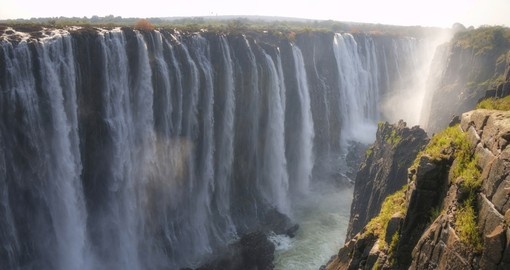Zimbabwe Nature and Wildlife
Nature
Zimbabwe Parks and Wildlife Management, under the Parks and Wildlife Board, is in charge of maintaining ten National Parks, nine recreational parks, four botanical gardens, four safari areas and three sanctuaries. These areas have been given the collective title of “Wildlife Estates” and cover an area of around 47,000 square kilometres (18,000 square miles), or roughly 12.5% of the total area of Zimbabwe.
Popular parks include Hwange National Park, Mana Pools National Park and Victoria Falls and Zambezi National Park. Hwange is Zimbabwe’s largest park and hosts one of the largest elephant populations in the world. Mana Pools is a UNESCO World Heritage Site because of its wildness and beauty which includes a wide range of large mammals, over 350 bird species as well as aquatic species.
Victoria Falls known locally as Mosi-oa-Tunya (“the Smoke that Thunders”), is one of the Seven Wonders of the World due to the fact that it is one of the most spectacular waterfalls in the world.
Wildlife
Zimbabwe is home to some of the best wildlife parks in southern Africa. The nature found throughout the country is remarkable, hosting various mammal, bird and reptile species. The plains house antelopes, zebras and giraffes and there is a good chance of seeing some of the “Big Five” (buffaloes, elephants, leopards, lions and rhinoceros). The “Big Five” was a term coined by big game hunters searching for the most difficult animals in Africa to hunt. The animals weren’t chosen for their size, but rather for the difficulty involved in capturing them. Zimbabwe boasts one of the last rhinoceros ranges that include small numbers of both white and black rhinos. Matobo National Park is one of the best and most accessible places to find these rare animals. (They can also be found in Hwagne and Matusadona National Parks).
There are approximately 685 bird species recorded in Zimbabwe. Birds have held special importance in Zimbabwe since the early days of the country. When the ruins of Great Zimbabwe were discovered, there were bird carvings on the walls and on monoliths throughout the ancient city. As a result, the Zimbabwe Bird, which resembles an eagle, is the country’s national emblem and adorns the flag and some currency. Matobo National Park is home to one-third of the world’s eagle species.
Along with birds are various reptile species. Chameleons and geckos are very common, and so too are legless snake lizards and rock-plated lizards, while the largest species in Zimbabwe is the leguaan or water monitor, which is often spotted lazing about watering holes. Zimbabwe and southern Africa in general do not have as many species of insects as their northern counterparts, however, there are an astonishing 500 species of butterflies found throughout the country, including the African monarch, the commodore and the citrus swallowtail.
Early in the 20th century, the people of Zimbabwe (then Rhodesia), recognized the threat to the country’s natural wildlife due to uncontrolled hunting of animals, as well as widespread commercial agriculture. They witnessed the numbers of creatures like elephants and rhinos steadily depleting and decided to take action by setting aside large “game reserves” just for wildlife. These reserves became the basis for the national parks that exist today. Locals were removed from those areas and were forbidden to hunt. The Wildlife Conservation Act was established in 1960 and has been revisited in later decades. In the 1990s, Zimbabwe became one of the leading countries in Africa regarding wildlife conservation and management.
While still concerned with wildlife protection, there are many challenges facing Zimbabwe today. With continuous pressure on the economy, many people in Zimbabwe have been forced to poach meat purely for survival. Also, animal skins, rhino horns and elephant tusks can fetch the equivalent of a year’s wages when sold. Many conservation groups recognize the struggles that local populations face and therefore aim to work with them on conservation projects. Victoria Falls Anti-Poaching Unit, established in 1999, is committed to finding alternative means of subsistence and job creation. One of their goals is to try and rehabilitate poachers rather than just punish them. They strive to reinforce the benefits of conserving natural resources by educating the public.
Zimbabwe Travel Information
At Goway we believe that a well-informed traveller is a safer traveller. With this in mind, we have compiled an easy-to-navigate travel information section dedicated to Zimbabwe.
Learn about the history and culture of Zimbabwe, the must-try food and drink, and what to pack in your suitcase. Read about Zimbabwe's nature and wildlife, weather and geography, along with 'Country Quickfacts' compiled by our travel experts. Our globetrotting tips, as well as our visa and health information, will help ensure you're properly prepared for a safe and enjoyable trip. The only way you could possibly learn more is by embarking on your journey and discovering Zimbabwe for yourself. Start exploring… book one of our Zimbabwe tours today!
Extend Your Trip
After your Africa tours, why not consider one of Goway's Europe tours or Egypt tours en route from Zimbabwe or perhaps a stopover in Dubai on one of our United Arab Emirates tours
Book your Zimbabwe tour with Goway!
 AfricaExperts is the exclusive division of Goway that specializes in planning and organizing Zimbabwe tours and experiences. Choose from an exclusive African safari, an independent travel module, a city stopover, a stay of distinction, a luxury rail journey and more. We want to be your first choice when next you go globetrotting to Zimbabwe.
AfricaExperts is the exclusive division of Goway that specializes in planning and organizing Zimbabwe tours and experiences. Choose from an exclusive African safari, an independent travel module, a city stopover, a stay of distinction, a luxury rail journey and more. We want to be your first choice when next you go globetrotting to Zimbabwe.
Get a Trip Quote Order a Brochure


















